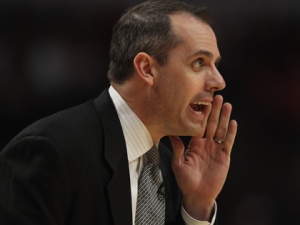Much like any good horror movie, the first one of the group to die off is usually the one that has the least power in the group and is thus deemed the most easily replaceable.
The NBA works much the same.
The Pacers’ extinguishing of Frank Vogel from the franchise via the ole passive aggressive “not renewing his contract” route could be seen a mile away, especially after team president Larry Bird refused to even give him a tepid vow of support after the Pacers lost in seven games to the Toronto Raptors.
As it often happens with underachieving, heads tend to roll in varying order by sport, but certainly in the NBA, by coach, then front office, then star player.
Of the three, the hardest to replace in Indiana is Paul George, the star player.
Bird has long surmised that within three to five years, players tend to tune out coaches. It’s Bird’s claim as to why he departed when the Pacers were at the summit of where they’ve been as a franchise, their only NBA Finals appearance in 2000.
Though there’s plenty of blame to go around, Vogel was the easiest scapegoat after this season. If you metered it out by percentage, he bore the highest share of the blame.
Bird has to look inward, especially with a franchise that seems to be terminally allergic to a consistent, deep bench. However, Vogel’s seemingly stubborn rotation changing, coupled with an offense that never seemed to be able to lift over cracks in the sidewalk, were more systemic issues for a franchise that has gone from annual Eastern Conference Finals contender to an often effortless team which gets a low playoff seed.
Very few know what really caused such deep fissures in a burgeoning, young power three years ago when the Pacers were trying to take down the Miami Heat, but all of a sudden, Roy Hibbert looked like someone ran over his dog every day.
David West, assumed to be a “leader,” slogged up and down the floor, especially on defense. Lance Stephenson was pissing off everybody. There were questions about what exactly was added with Evan Turner, who never seemed to fit in.
The Pacers, almost overnight, started playing like guys who hated the smell of each other, and wouldn’t be caught dead hanging out together for drinks unless forced to at gunpoint.
After that, the microscope was turned inward. How did the culture get this bad? Could it be changed? If Hibbert is going to continue to be terrible and West is going to continue to half-arse it back on defense, is the coach going to make anyone accountable?
When George suffered a gruesome leg injury, it probably shone a light on Vogel’s brightest work, cobbling together enough wins to get George back for the last six games of the 2015 season with an actual playoff spot still available.
As crazy as it sounds to say that, only one year later, he’s gone.
Bird, at times, has gotten his hands in the cookie jar a bit. It’s been well known that there are certain players Bird wants on the floor, and the mini-rift with PG playing the four spot caused more than a few people to wonder why the GM is instructing where the star player is going to be.
However, Bird has been pretty open for the most part about what he’s wanted out of the roster, and Vogel never was able to deliver that. The 2015-’16 version of the team was revamped to be a sleeker, faster model, albeit without a true point guard.
That part is not Vogel’s fault.
What is, though, is that when Ty Lawson was acquired, in spite of at times (read: not ALL the time) playing with much more fluidity than Monta Ellis and George Hill, he seemed mostly stapled to the bench.
All series long against the Raptors, you’d have thought Jordan Hill was abducted by aliens if you didn’t have proof of him existing on television, sitting. More to that point, the Pacers were obliterated on the glass while arguably their best rebounder sat.
It’s that rigidity with rosters and curious in-game decision making which sunk Vogel. A particular instance of a poor in-game choice was a timeout called late in Game 7 against Toronto when the Pacers had numbers in a game-tying situation, only to draw up a play for Ian Mahinmi, the weakest offensive player on the team and an inconsistent foul shooter.
Over his time with the Pacers, Vogel has done his best work when the team was backed into a corner. For the most part, that hasn’t been often.
Though the offense has evolved over the last few seasons from “high ball screen every play,” Vogel and his staff never made the game rotation malleable enough to keep anyone honest if they weren’t all in effort-wise.
Whether you believe there’s anything behind it or not, in the wake of Vogel’s departure, there was silence from Pacer players on social media. Who knows what that means, if anything, but they sure were taking to the Twitter three years ago when Brian Shaw departed for the Denver Nuggets.
Maybe it’s something, maybe it’s nothing. It probably is the latter.
However, the bottom line is that the Pacers were too predictable on offense. They suffered an erosion of culture that was often marked by poor effort at worst, inconsistent desire at best, and too little in-game flexibility. The majority — make that a very high percentage — of coaching is motivating, no matter what anyone says.
The Pacers haven’t played consistently motivated for the better part of the last three years.
There’s plenty of blame to go around, but when the chickens come to roost in this sort of situation, the coach is typically the first one to go down. Next time, the fall guy won’t likely be the same.

